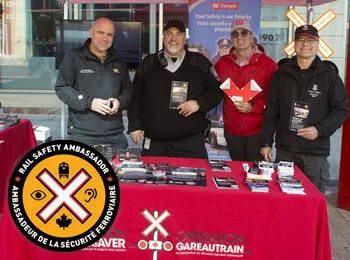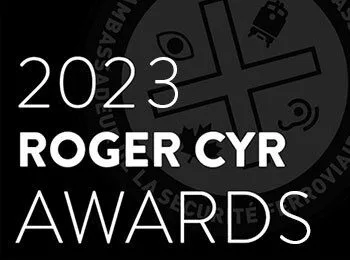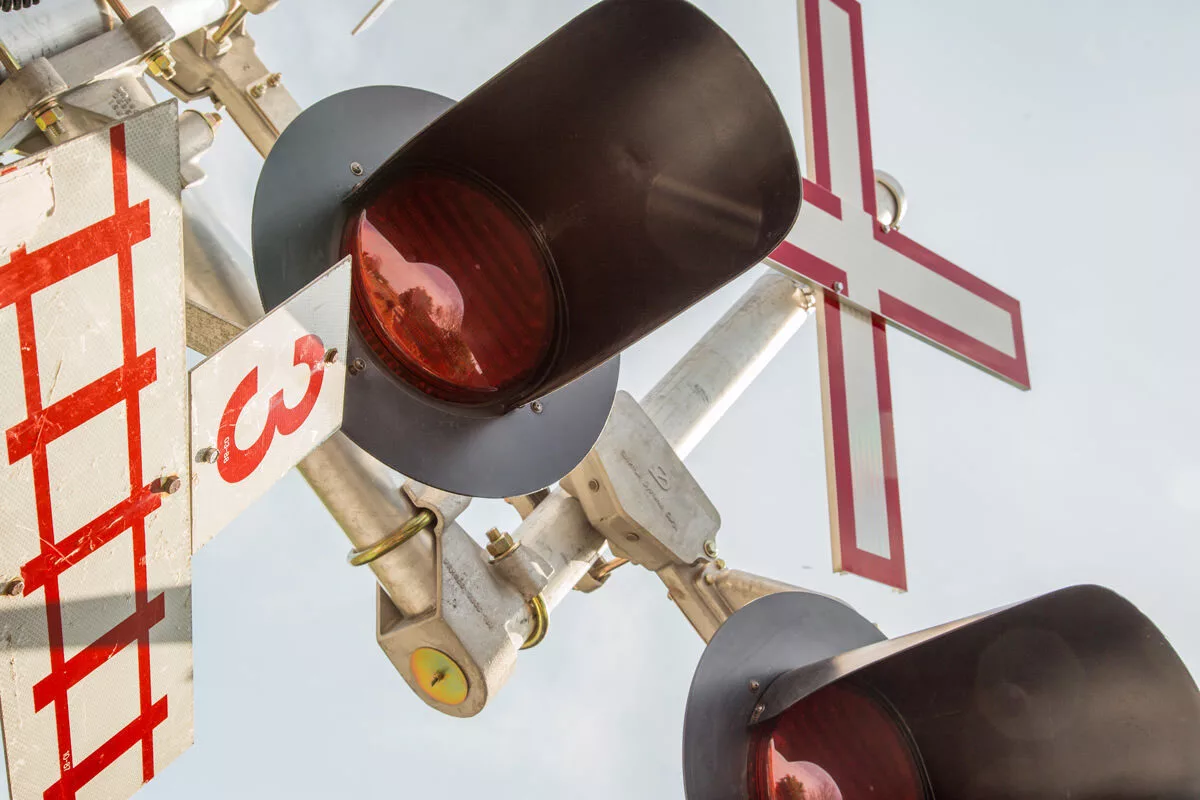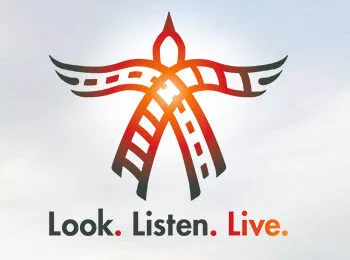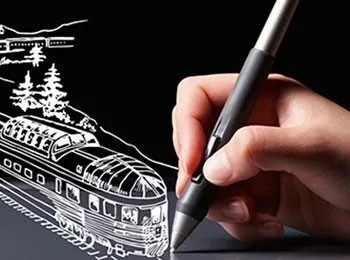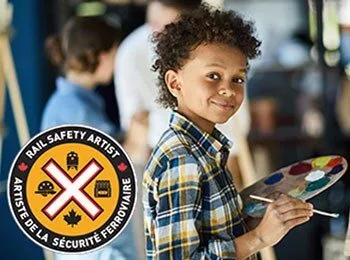Signs and Devices
Whether you’re driving, cycling or walking, knowing what railway warning signs and devices mean—and how to act when you see them—is key to staying safe around railway crossings and tracks. Click on the animated graphics below and test your rail safety knowledge—it could save your life.
Test Your Rail Safety Knowledge
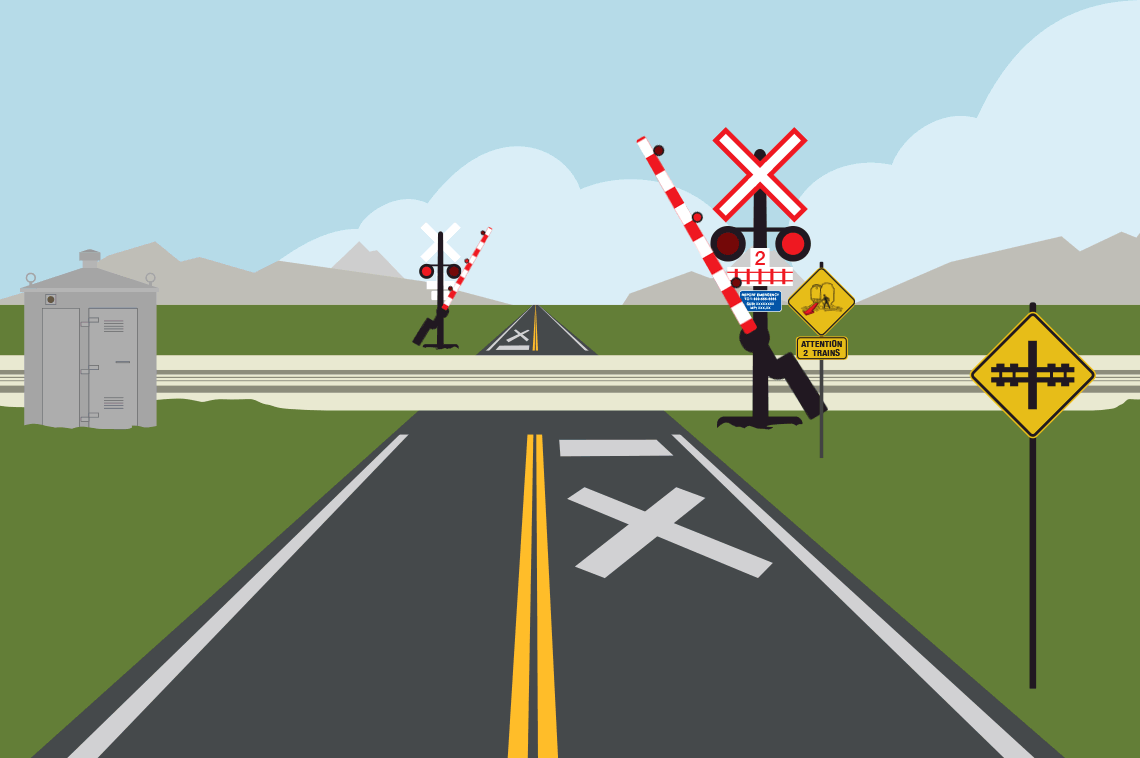
Signal House
You can find the railway’s emergency phone number and crossing location on the signal house and on the blue Emergency Notification Sign at the crossing.
Train Whistle/Bell
Locomotive engineers will sometimes sound their engine’s whistle/bell when approaching railway crossings. But be careful: some municipalities don’t allow trains to sound their whistles at certain crossings. Also, you may not hear the warning if you’re distracted or listening to music. Turn off any music, ask passengers to be quiet, and open your window to listen for approaching trains.
Crossbuck
This crossbuck sign marks where the railway tracks are located. Often a crossbuck will be accompanied by a sign that will tell you how many tracks are at the crossing. If there is more than one track, there could be more oncoming trains.
Pavement Markings
A large “X” and/or stop lines painted on the pavement let you know that a railway crossing is up ahead. Be especially alert at passive crossings, since they don’t have warning devices such as flashing lights or gates. Slow down, look both ways, and listen for oncoming trains. You must come to a full stop behind the stop line, or at least 5 metres from the nearest rail, if any of the following are present: a flagman or a police officer signals you to stop, a stop sign is posted, trains are approaching, or you hear a train whistle.
Tracks
Never stop on the tracks—once you’ve entered a crossing, keep moving. To avoid stalling on the tracks, never shift gears while proceeding through a crossing. Don’t proceed unless you’re sure your vehicle can completely clear the crossing.
Emergency Notification Sign (ENS)
If a train-vehicle collision is imminent, move at least 30 metres away from the tracks. For all emergencies, or to report dangerous conditions at a crossing, call the phone number on this sign (or dial 911 if a sign isn't visible). The mile post and subdivision listed on the sign will help the railway to identify your location. This information can also be found on the signal house.
Two Trains
This sign warns drivers and pedestrians that there could be a second train arriving at a crossing. Always look both ways to ensure that all trains have passed and all tracks are clear before crossing.
Advance Warning Sign
Slow down, look both ways, listen for approaching trains, and be prepared to stop; trains always have the right of way. This advance warning sign lets you know you’re approaching a railway crossing.
Crossing Gates
Stop—it’s illegal to go around lowered crossing gates or to ignore railway warning signs or signals at a rail crossing. Be aware—not all crossings have gates and/or flashing lights. This does NOT mean the railway is not in use or that no trains are approaching. Regardless of the signage, always be prepared to stop at rail crossings.
Remember:
- Avoid distractions
- Be prepared to stop at all crossings
- Slow down, look both ways, and listen for oncoming trains
- Follow all railway warning signs and signals
- Cross at a 90° angle if crossing on a bike, as wheels can become stuck
- Check that there’s enough room for your vehicle on the other side of the tracks before crossing
- Never race a train
- Never stop on the tracks
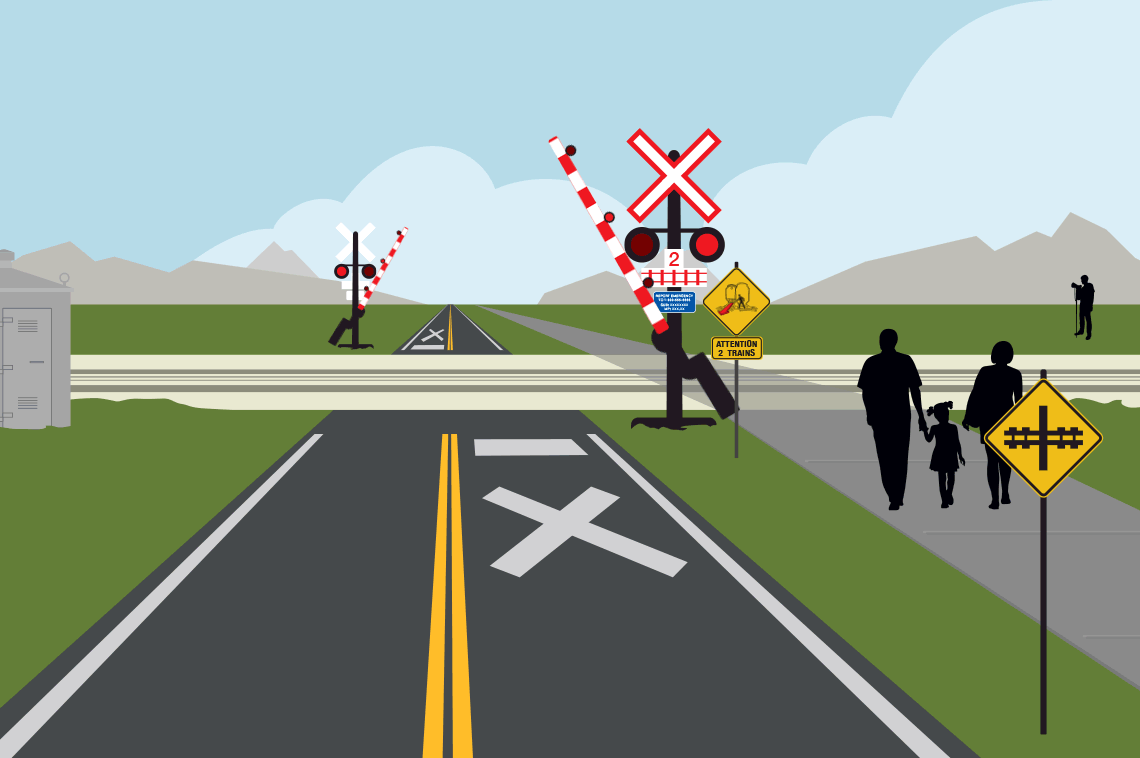
Signal House
You can find the railway’s emergency phone number and crossing location on the signal house and on the blue Emergency Notification Sign at the crossing.
Train Whistle/Bell
Locomotive engineers will sometimes sound their engine’s whistle/bell when approaching railway crossings. But be careful: some municipalities don’t allow trains to sound their whistles at certain crossings. Also, you may not hear the warning if you’re distracted or listening to music. Turn off any music, ask passengers to be quiet, and open your window to listen for approaching trains.
Crossbuck
This crossbuck sign marks where the railway tracks are located. Often a crossbuck will be accompanied by a sign that tells you how many tracks are at the crossing. If there is more than one track, there could be more oncoming trains.
Two Trains
This sign warns drivers and pedestrians that there could be a second train arriving at a crossing. Always look both ways to ensure that all trains have passed and all tracks are clear before crossing.
Advance Warning Sign
This advance warning sign lets motorists, cyclists, and pedestrians know they’re approaching a railway crossing. Be prepared to stop; trains always have the right of way.
Emergency Notification Sign
If a train-vehicle collision is imminent, move at least 30 metres away from the tracks. For all emergencies, or to report dangerous conditions at a crossing, call the phone number on this sign (or dial 911 if a sign isn't visible). The mile post and subdivision listed on the sign will help the railway to identify your location. This information can also be found on the signal house.
Pedestrian Crossing
ONLY cross tracks at designated railway crossings—this is the only safe place to cross. Crossing anywhere else is illegal and considered trespassing—you could be ticketed or fined. Stay behind any gates, stop lines, or at least 5 metres from the tracks when waiting for trains to pass. Trains are wider than the tracks and can carry wide loads—if you’re too close, you could get hit.
Avoid Distractions
Before you cross, make sure you stop, look both ways, and listen for oncoming trains. Don’t be distracted by friends, phones, or music.
Stay Clear of Tracks
Don’t put yourself or others at risk by taking photos on or near railway tracks, tunnels or bridges. Never loiter on or near the tracks.
Remember:
- Stay alert—it’s easy to get distracted by phones, music, and conversations
- Stop, look both ways, and listen for oncoming trains
- Follow all railway warning signs and signals
- Only cross tracks at designated railway crossings
- Cross quickly―never stop on the tracks
- Cross at a 90° angle if crossing with a stroller or wheelchair, as wheels can become stuck
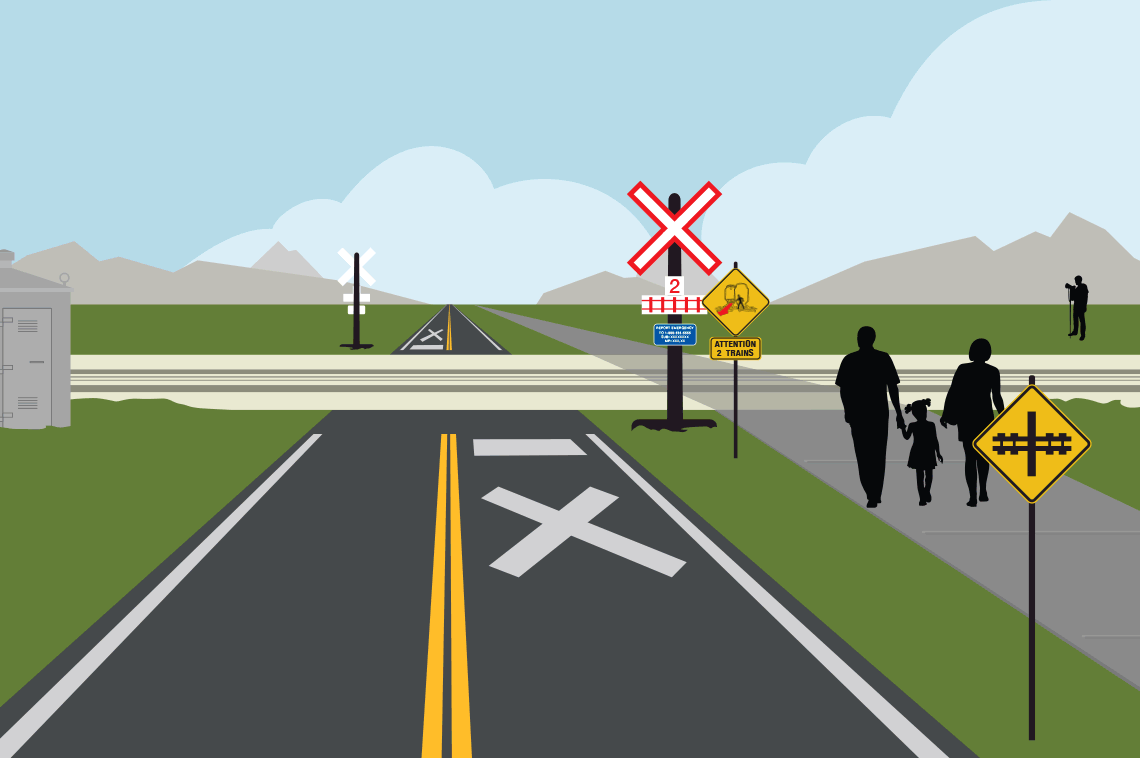
Signal House
You can find the railway’s emergency phone number and crossing location on the signal house and on the blue Emergency Notification Sign at the crossing.
Train Whistle/Bell
Locomotive engineers will sometimes sound their engine’s whistle/bell when approaching railway crossings. But be careful: some municipalities don’t allow trains to sound their whistles at certain crossings. Also, you may not hear the warning if you’re distracted or listening to music. Turn off any music, ask passengers to be quiet, and open your window to listen for approaching trains.
Crossbuck
This crossbuck sign marks where the railway tracks are located. Often a crossbuck will be accompanied by a sign that tells you how many tracks are at the crossing. If there is more than one track, there could be more oncoming trains. Sometimes a crossbuck is also accompanied by a stop sign, in which case you need to stop behind the stop line, or at least 5 metres from the nearest rail. Always look both ways and listen for trains before crossing the tracks.
Two Trains
This sign warns drivers and pedestrians that there could be a second train arriving at a crossing. Always look both ways to ensure that all trains have passed and all tracks are clear before crossing.
Advance Warning Sign
Slow down, look both ways, listen for approaching trains, and be prepared to stop; trains always have the right of way. This advance warning sign lets you know you’re approaching a railway crossing.
Emergency Notification Sign
If a train-vehicle collision is imminent, move at least 30 metres away from the tracks. For all emergencies, or to report dangerous conditions at a crossing, call the phone number on this sign (or dial 911 if a sign isn't visible). The mile post and subdivision listed on the sign will help the railway to identify your location. This information can also be found on the signal house.
Stay Clear of Tracks
Don’t put yourself or others at risk by taking photos on or near railway tracks, tunnels or bridges. Never loiter on or near the tracks.
Tracks
Never stop on the tracks—once you’ve entered a crossing, keep moving. To avoid stalling on the tracks, never shift gears while proceeding through a crossing. Don’t proceed unless you’re sure your vehicle can completely clear the crossing.
Pavement Markings
A large “X” and/or stop lines painted on the pavement let you know that a railway crossing is up ahead. Be especially alert at passive crossings, since they don’t have warning devices such as flashing lights or gates. Slow down, look both ways, and listen for oncoming trains. You must come to a full stop behind the stop line, or at least 5 metres from the nearest rail, if any of the following are present: a flagman or a police officer signals you to stop, a stop sign is posted, trains are approaching, or you hear a train whistle.
Remember:
- Be extra cautious as passive crossings don’t have flashing lights or gates
- Be prepared to stop at all crossings
- Slow down, look both ways, and listen for oncoming trains
- Follow all railway warning signs and signals
- Never race a train
- Never stop on the tracks
